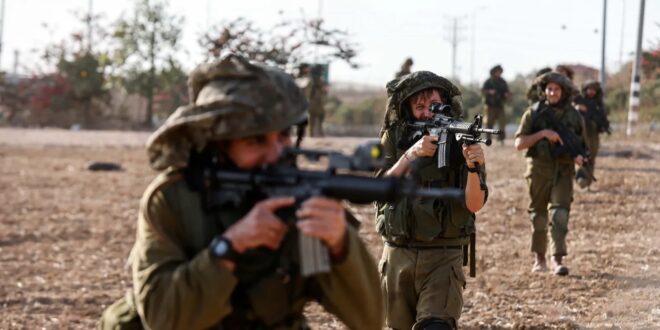Fighting Hamas in Gaza Will Be Difficult and Costly
Although the details are still difficult to predict, it seems very likely that Israel will mount a land invasion of the Gaza Strip in the near future. If and when that happens, the campaign will feature several elements common to any large-scale, high-intensity urban battle. In the Iraqi cities of Fallujah, Mosul, and Ramadi; the Philippine city of Marawi; the Ukrainian cities of Bakhmut and Mariupol; and many other places, military forces in this century have wrestled with the persistent complications of fighting in urban spaces.
A potential ground assault into Gaza would be no different. It would entail horrendously difficult tactical conditions, including room-to-room combat and tunnel warfare that would lead to massive casualties. It would require fighting on the ground, in the air, and at sea—fighting that must be done in a carefully synchronized fashion. Combat will be slow and grinding, and the resulting devastation will almost certainly test international support for Israel’s invasion. Israeli war planners are almost certainly considering these operational and strategic issues as they decide whether to invade, and—if they go forward—how best to proceed.
LAND, SEA, AND AIR
Most conflicts since the turn of the century have occurred in urbanized, networked, densely populated environments. This is because wars happen where people live, and the world has been urbanizing since the Industrial Revolution. Since 2008, more than half the global population has lived in cities, and experts have predicted that the world population will be 67 percent urbanized by the middle of this century. Moreover, human settlements cluster on coastlines, so urban conflicts require that forces operate on land and sea as well as in the air. As military forces field longer-range weapons, inland areas can increasingly be targeted with sea-based weapons, and land-based weapons can target ships at sea. In this sense, the whole eastern Mediterranean forms a single regional theater, influencing and influenced by events on the ground in Gaza.
In 2015, recognizing the growing importance of urban conflict, NATO commenced a project to study the enduring challenges of urbanization. The project involved multiple rounds of war-gaming and experimentation, and it drew on work by 18 of NATO’s centers of excellence along with science and technology organizations within NATO and the Five Eyes alliance (which includes Australia, Canada, New Zealand, the United Kingdom, and the United States). It also examined the impact of emerging and disruptive technologies on future urban operations. NATO’s findings are a useful starting point for understanding conflicts like the one looming in Gaza.
NATO researchers called urbanized environments an “urban quad” because cities combine built-up terrain with a dense population, complex systems of infrastructure, and a networked, globally connected information environment. Fighting in such environments is characterized by friction, density, complexity, and threats that can emerge at any moment from any direction. Urban combat is slow, grinding, destructive, environmentally devastating, and horrendously costly in human life—especially for civilians. It involves house-by-house, block-by-block fighting that soaks up troops and firepower in enormous quantities, as every room, street corner, rooftop, sewer, and basement must be secured before the next can be taken. Such combat is particularly dangerous for junior combat leaders, who must constantly expose themselves in order to see, communicate with, and command their soldiers.
Urban warfare is supremely demanding. Specialists such as combat engineers, snipers, medics, heavy weapons teams, and drone operators are valuable and hence heavily targeted. Armored vehicles, including armored bulldozers, are critical and have played a key role in recent battles, such as those in Ramadi and Mosul in Iraq. Armor has also been critical in Bakhmut and Mariupol. Armored vehicles are highly vulnerable, however, unless accompanied by infantry to deal with antitank weapons, mines, and improvised explosive devices. Support from tanks is vital, in turn, for protecting infantry on the ground. Artillery, mortars, and rockets are needed to strike enemy reinforcements and hit targets farther away. Modern militaries build a “kill web” of observers, sensors, and communications to feed targets to these longer-range weapons. Commanders try to achieve a combined-arms effect whereby enemies expose themselves to one threat—a drone or artillery strike from overhead, for example—as they seek to avoid another, such as a tank or infantry squad at street level. But this is far easier said than done.
Urban combat may appear land-centric, but in fact aerospace plays a critical role. Airstrikes—from piloted aircraft, drones, or robotic and autonomous systems including kamikaze drones and drones carrying explosive charges—are crucial to enabling forces to maneuver on the ground. This is because of the combined-arms effect: an enemy that disperses to avoid airstrikes becomes vulnerable to ground attack, whereas one that concentrates to fight another force on the ground creates a target for airstrikes. Likewise, surveillance and reconnaissance from air- and space-based sensors are critical to making sense of cluttered, complex urban environments. Space-based communications and navigation systems are fundamental for targeting and command. Cyberwarfare and electronic warfare are also features of this environment.
Urban combat is slow, grinding, destructive, and horrendously costly in human life.
Sea-based systems are crucial as well. Together, warships, carrier-based aircraft, naval gunfire support, and sea-launched drones and missiles enable a force to maneuver by sea, remaining outside the urban environment while striking adversaries onshore. Sea control also allows the landing of amphibious or helicopter-borne troops in unexpected locations, dislocating an enemy’s urban defenses. A seaborne reserve can create flexibility for a ground commander, enabling freedom of maneuver in otherwise static urban battles. Sea denial—preventing adversaries from using the sea—may require land-based antiship missiles as well as surface ships, fast-attack craft, crewless surface vessels, or underwater drones. All these elements have been in play during recent battles in Ukraine, where Ukrainian forces made excellent use of them against the Russian navy in the Black Sea.
Both sides in the Gaza conflict have some or all of these naval systems. The Israeli navy possesses fast attack craft, missile boats, and patrol boats as well as larger warships and naval special forces. Hamas has its own maritime commando force, Nukhba, which led a seaborne raid on Zikim Beach in Israel during the opening moves of the attack on October 7, capturing a military base south of Ashkelon. More broadly, the importance of sea-based systems is evidenced by the U.S. Navy’s deployment of two carrier strike groups into the region, giving it the ability to shoot down incoming missiles targeting Israel (as U.S. warships have already done). A Chinese naval task group is also in the wider region, and Russian aircraft with long-range Kinzhal missiles are deploying over the Black Sea—well within strike range of naval forces operating off Gaza, including the U.S. aircraft carriers.
Back on land, for soldiers and civilians in the midst of urban fighting, the danger, the fatigue, the sense of perpetual threat from every direction, and the horror of close-range hand-to-hand combat all take an immense physical and psychological toll. Battles tend to be confused, fleeting (measured in seconds), and short range, with targets often closer than 50 yards. Troops may be focused on the house or room they are fighting in, but at the same time they may also be targeted from a distance by mortar crews, snipers, and drone operators.
All this is well known to anyone with combat experience in the last 20 years. It is also, of course, very familiar for the Israel Defense Forces (IDF), whose experience in urban battles in Jenin in the West Bank in 2002, southern Lebanon during the war with Hezbollah in 2006, and the Palestinian territories informs much recent thinking on urban warfare.
LIMITING CIVILIAN CASUALTIES
In Gaza, a key initial IDF objective was to separate Hamas fighters from civilians. This was partly to protect the population and partly to identify legitimate targets. But this is one of the hardest aspects of urban combat, given that enemy forces are often dug in and embedded in noncombatant populations that, whether or not they support the adversary, become human shields. Late last week, Rear Admiral Daniel Hagari, the IDF spokesperson, stated that Israel’s “focus has shifted from precision to damage and destruction” in an effort to make Gaza untenable as a Hamas base. This suggests the IDF is placing less emphasis on avoiding civilian targets than before.
In any case, efforts to encourage civilians to leave through official crossing points or designated humanitarian corridors will only partly succeed if recent experiences in Marawi and Mosul are any guide. In both cities, attempts to create humanitarian corridors were hampered by terrorists who blocked civilians from leaving. IDF spokespeople have claimed that Hamas is blocking civilians from leaving today. Even when civilians try to leave, the destruction and chaos of urban combat make it extremely dangerous and difficult for them to do so, leading many to shelter in place. Despite its official shift from precision to destruction, the IDF in fact has a strong track record of seeking to avoid civilian casualties, including through pre-strike warnings and so-called roof knocking, in which low-yield or nonexplosive devices are dropped on rooftops to encourage civilians to leave before the main strike. In the event of a full-scale ground assault, the IDF can be expected to bring forward humanitarian and civil affairs teams to evacuate, screen, and support civilians while filtering out enemy fighters who are seeking to hide within the flow of displaced people. But such efforts can only do so much, and the chaos and uncertainty of battle frequently lead to mistakes that cost civilian lives.
Gaza City, Khan Younis, and Rafah (the three most heavily populated parts of the Gaza Strip) are mazes of multistory concrete and brick buildings that are often poorly constructed, rickety, and prone to collapse under artillery or airstrikes. This is hugely dangerous for trapped civilians, as well as for soldiers: damage to urban structures can limit troops’ ability to maneuver, blocking streets with rubble and channeling advancing forces into killing areas. This was one reason the battle of Mosul took so many months, as defenders fought amid the ruins, emerging from the wreckage to mount aggressive counterattacks, besieging headquarters and logistics installations from unexpected directions.
In Gaza, Hamas has spent almost two decades developing a dense network of defenses, including one of the most extensive hardened tunnel systems ever seen in urban combat, a web of underground passages that Hamas claims stretches more than 300 miles. Subterranean warfare, including in tunnels so close to the coast that they are periodically subject to flooding, will likely be one of the most challenging aspects of the battle. Robotic and autonomous systems, including drones capable of exploring tunnel systems and engaging enemies underground or underwater, can help clear underground passageways. Flooding, tear-gas, and other tools can also be critical when fighting in tunnels, basements, or interior spaces. But with noncombatants crowding into such spaces, these methods bring potentially catastrophic risks to civilians. Ultimately, there is no substitute for humans with weapons, sensors, specially trained dogs, and night-vision devices to clear such tunnels. It will be a difficult, deadly, and excruciatingly slow task.
KNOW YOUR ENEMY
Hamas is a technologically enabled, socially embedded force fighting on its home terrain. Its fighters operate in small networked teams that are armed with lethal weapon systems of the kind that, in recent memory, were largely only available to the armed forces of nation-states. Hamas’s tactics are likely to involve network defense: holding strongpoints to delay and disrupt IDF advances while keeping mobile forces in reserve, ready to counterattack or re-infiltrate cleared areas. They will make extensive use of military off-the-shelf weapons as well as booby traps and improvised explosive devices. Hamas has also already demonstrated its ability to fight a sophisticated information war to mobilize international support.
What started as a horrific attack on Israeli civilians, exploiting shock and surprise, is now likely to congeal into a grinding, slow, contentious, and costly battle in the air, on land, on the sea, and in cyberspace. In Gaza’s complex, cluttered, heavily populated and densely urbanized environment, it will be extraordinarily difficult to make sense of what is happening, even for those on the ground. The effect of emerging technologies, the enduring features of urban combat as identified by NATO—friction, density, complexity, and all-directional threats—along with the physical, human, informational, and infrastructure constraints that cities impose on military forces will all inform what is about to unfold.
Understanding the tactical difficulty of urban warfare adds context that Israel can use to evaluate the wisdom (or otherwise) of any full-scale ground assault in Gaza. IDF planners are likely concerned that once their forces are decisively committed to ground combat in Gaza, other regional players—Hezbollah in Lebanon, Iranian-backed militias in Syria, or Iranian forces themselves—might attack Israel, creating a multifront war. This possibility might prompt Israel to mount a preemptive strike on regional players before entering Gaza, but such a strike would be a high-stakes gamble.
A ground campaign in Gaza also carries strategic risk. Amid information warfare from Hamas and Iran, the destruction of property, civilian casualties, and the expulsion of the population—likely painted, at best, as ethnic cleansing—of an urban battle in Gaza could damage Israel’s moral legitimacy, forcing a political halt regardless of progress on the ground. U.S. soldiers and marines experienced this during the first battle of Fallujah in April 2004 in Iraq, when an international outcry forced the Bush administration to halt the battle despite significant progress, giving insurgents the breathing space to consolidate defenses before a second battle that November. Arguably, this political squeamishness cost American lives. But the strategic effect of lost moral legitimacy could be extraordinarily severe—both for Israel and for its allies, including the United States.
All these factors suggest that a ground assault into Gaza is likely to be horrific, with dire consequences. But as every soldier knows, it may still be necessary—and it may start very soon.
 Eurasia Press & News
Eurasia Press & News




